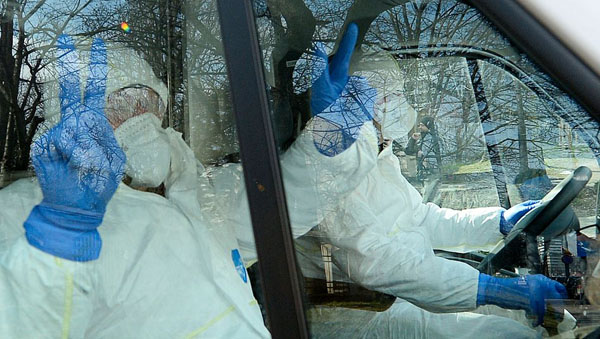Interview with Vlad B.

- Hi Vlad. We see fewer cases of Covid19 and deaths so far in Eastern Europe compared to the rest of Europe and at the same time a small number of testing, which means that the real numbers may be much higher. How is the situation?
It’s true, the countries in Central and Eastern Europe have less cases for now: the most recent figures as of 5 April showed that the three worst hit countries in the region are Czechia, Poland and Romania. They have between 3800 and 4500 confirmed cases and between 60 and 150 deaths, so much less than countries like Belgium and Netherlands, not to mention Italy and Spain. That is because the pandemic reached this region a bit later, but it’s also due to the lack of mass testing that you’ve mentioned. There is barely any testing for the medical staff not to mention the wider population. So, the official figures are just the tip of the iceberg. And we are just at the beginning. Most of the countries in the region are emigration countries, especially Romania, Poland, Bulgaria, Lithuania. Romania, in particular, has about 2 million emigrants in Italy and Spain. Many of them have come back since the outbreak of the virus and only a few of them were put in the 14-day quarantine. So, it’s a ticking bomb, really. Now the right-wing president Klaus Iohannis is appealing to the diaspora to stay put and not come home, only a few months after he glorified the diaspora to get their votes.
- The underfunded health services across the region, the lack of protective equipment etc means that the situation can get much worse. We have read that in a city in Romania, in Suceava, the city’s hospital was closed after 100 medical staff was contracted by the virus. What is the actual situation of the health system?
Yes, the health systems in this region are chronically underfunded. Official data for 2018 shows that, across the EU, average public spending on healthcare as part of GDP is around 7%, which is already too low. But with the exception of Slovakia and Czechia, all the other states from our region fall under that average and most fall even under 5%. Italy spends 7% on public healthcare and look how they’ve been struggling. Imagine how a country like Latvia will cope with this, which only spends 4% of the GDP! On top of that, in Romania alone, hundreds of hospitals were closed as part of the austerity measures from the early 2010s. Austerity targeted healthcare across the EU and it was a criminal policy whose effects will come out in full display now.
It must be said that underfunding is the main but not the only problem. At least in Romania, hospitals are heavily characterised by what we can only call feudal relations, where authoritarian and often corrupt managers and high-ranking doctors treat fellow colleagues and ordinary patients as their personal servants. It was this abusive management style that contributed to the catastrophic situation in the Suceava hospital that you mentioned. That hospital is now being run by military doctors, which is equally bad. So massive public funding must be coupled with the introduction of democracy in the workplace, where doctors and nurses decide how the institution and the wider sector is to be run most effectively.
The way the problem with the hospital management in Suceava was solved also reflects how Romanian authorities have been dealing with this crisis: more focus on disciplinarian measures than effective support to the medical sector. We see more restrictions, fines, and police cars loudly playing the national anthem instead of mass testing, protective equipment and ventilators.
- Talking about measures, what social and economic measures have been taken so far to tackle this crisis?
Non-essential work has been stopped, although the definition of that is subject to wide interpretation. The states are covering part of the wages for workers sent in technical unemployment, ranging from 40% in Poland (with the employers having to match that up) to 75% in Romania, while in most cases self-employed workers are to get a one-off payment from the state.
Also, the repayment of bank loans is postponed on request, without interest, during the state of emergency. In Romania, on Friday the Parliament also voted the possibility to postpone key utilities bills for 3 months. While such measures have some positive elements and give a lifeline to many workers, they are also very limited and fragile. The right-wing, provisional government in Romania already said it will challenge at the Constitutional Court what the Parliament voted on Friday! Previously, they approved the postponement of rents, but only for companies. This shows that, across the region, governments are primarily concerned to defend business interests, which reflects their political character, ranging from the neoliberal to the populist and nationalist right. At the same time, they are forced to provide a minimal safety net to working people, while also boost funding for the healthcare system.
However, these governments have very little material basis to do all that for too long, not to mention to deal with the longer-term economic impact of this crisis. Firstly, many states are running high budget deficits already and access to financial markets might be severely restricted in the coming period. Secondly, the little industry that these countries still have after the mass privatisations of the 1990s is mostly owned by foreign capital. This means they would not even reconvert existing factories to produce what is necessary to combat the pandemic. For example, the Ford factory in the US is now producing ventilators, while the Ford factory in Romania is sending workers in technical unemployment. Thirdly, the disruption of international trade will disproportionately affect the economies of many of these countries, where exports account for over three quarters of the GDP in the cases of Czechia, Lithuania, Hungary and Slovakia. In short, these governments utterly lack the economic space of manoeuvre for a Keynesian type of scenario that might be favoured in some circles at the level of the EU and some stronger member states.
- How do people, the workers and the poor who are the most affected by this epidemic, see all this?
The impact on consciousness of all this crisis and its socio-economic effects will be huge around the world and Central and Eastern Europe will be no exception. We can already see how the myth of the self-regulating market, propagated for decades, is now being pulverised. The invisible hand is invisible because it simply doesn’t exist. Neoliberal politicians cannot defend today some of the principles they held as self-obvious yesterday. In particular, people understand the paramount importance of the public healthcare system. If the public healthcare system fails, it’s because it’s poorly funded and poorly managed; if the private healthcare system fails, it’s precisely because it’s private: the goal is not human wellbeing but profit. The last few months in Romania saw pressure from the neoliberal government to accelerate the privatisation of the healthcare system, but I think now this is off the table for the foreseeable future.
Many working people can also see more clearly that they are the real wealth creators in society. This crisis may well see a rediscovered working class pride and consciousness. Also, the case for public ownership over key sectors of the economy seems more obvious to many people. As the fundamental contradiction between profit maximisation and human needs is coming in full display, we are already witnessing a shift in consciousness that otherwise would have taken years – time is compressed in crises like this.
However, it is important to remember that this impact on consciousness is neither even, nor universal. Some workers might be reaching anti-neoliberal conclusions now, but maybe not yet anti-capitalist or socialist conclusions. Others, by contrast, are moving towards a nationalistic narrative, that each nation is by itself and has to look after its own etc. Most people, though, are at the moment very confused and looking for answers. Where the left is developed enough to provide those answers, to offer an alternative, significant numbers of workers and youth could be moving leftwards in the coming period.
We need to be honest in our analysis and admit that in Central and Eastern Europe such a left is still missing. Hence, the nationalist, protectionist narrative might prevail and be exploited by right-wing forces to consolidate their current power. So, on a short-to-medium term, we may see reaction reinforced. However, these forces will prove incapable to solve the myriad of socio-economic problems that will only intensify as a result of this crisis. This explains the authoritarian measures that some are already taking, such as Orban in Hungary, who is now ruling by decree, or the Polish government, who wants to postpone presidential elections by 2 years!
But this can only buy them more time. Their lack of real solutions will most likely lead to social turmoil and mass upheaval, pushing consciousness further to the left and creating new opportunities for socialists to intervene and lead the struggle. That’s precisely why it has never been more imperative in recent history for socialists to organise. Our ISA comrades in the region are already doing that, for example by helping to organise a strike committee in the postal services in Poland, which are all the more vital in this period. In conclusion, this crisis will polarise things at all levels. The arguments for socialism will become more crystal-clear, so we need to already adapt to that and be bold in proposing a socialist, democratic and internationalist alternative to this criminal and irrational system.



